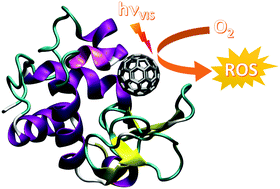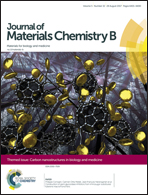C60@lysozyme: a new photosensitizing agent for photodynamic therapy†
Abstract
C60@lysozyme showed significant visible light-induced singlet oxygen generation in water, indicating the potential of this hybrid as an agent for photodynamic therapy. The reactive oxygen species (ROS) concentration generated by C60@lysozyme during irradiation depends on the light source, the irradiation time and the concentration of the hybrid. C60@lysozyme significantly reduced the HeLa cell viability in response to visible light irradiation. The generation of H2O2, due to the photoactivity of C60@lysozyme, causes cell death via easy permeation of hydrogen peroxide through the cell membrane and activation of endogenous ROS production.

- This article is part of the themed collection: Carbon Nanostructures in Biology and Medicine


 Please wait while we load your content...
Please wait while we load your content...